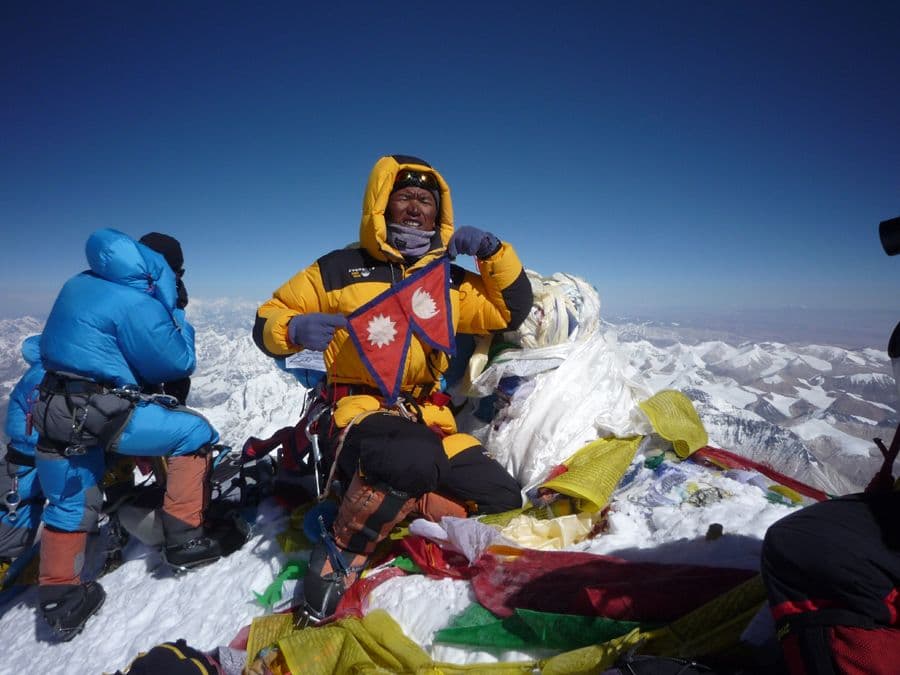
Everest Expedition
Mount Everest, the greatest challenge, is more than just the most famous mountain on Earth. It possesses a unique beauty, mystery, and mood. A successful Everest expedition leaves one feeling like the most proud and adventurous person on the planet.
Mount Everest, the greatest challenge, is more than just the most famous mountain on Earth. It possesses a unique beauty, mystery, and mood. A successful Everest expedition leaves one feeling like the most proud and adventurous person on the planet.
Mt. Everest’s local names reflect the deep respect it commands from all who behold it. Standing incredibly tall, silhouetted against the shared sky of Nepal and Tibet, this mountain is known by many names: Chomolungma, Sagarmatha, Qomolungma/Chomolungma, or simply Mt. Everest (8,848.86 m). Whichever name one chooses, its mystique continues to endure. For most mountaineers, reaching the summit of Everest is a lifelong dream. Many trekkers, meanwhile, find great fulfillment simply by viewing the mountain from Kala Pattar, Gokyo Ri, or by visiting Everest Base Camp.
The South Col route on the Nepalese side of Mt. Everest is the path first taken by Sir Edmund Hillary and the late Tenzing Norgay Sherpa
Trip Facts
Group Size
2-15 persons
Maximum Elevation
8848.86 m
Location
Everest Region, Nepal
Route
Southern routes
Grade
Mountaineering VII
Best Season
Spring
Accommodation
Hotel and Camping
Transportation
By Flight (to/from Lukla) and trek to base camp.
Achieve the ultimate mountaineering goal the summit of Mount Everest (8,848.86 m / 29,032 ft) with the guidance and support of Asian Hiking Team.
Trek through the heart of Sherpa country, visiting famous villages such as Namche Bazaar, Tengboche Monastery, Dingboche, and Lobuche rich in culture, history, and breathtaking scenery.
Professional Support and Safety: Benefit from the expertise of Asian Hiking Team’s experienced Sherpa guides, expedition leaders, and logistics crew. All focused on your safety, success, and enjoyment. Spend time at Everest Base Camp (5,364 m) beneath the towering Khumbu Icefall, joining an international community of climbers and expedition teams.
Enjoy spectacular panoramic views of the world’s highest peaks: Lhotse, Nuptse, Makalu, Cho Oyu, and many more.
Challenge yourself physically and mentally and return home with the pride of having attempted or summited the world’s highest mountain.
- Pick up / Drop from International Airport to Hotel.
- Kathmandu to Lukla/KTM both way flight ticket.
- Hotel in Kathmandu with breakfast as itinerary (here are so many options, we provide on cost 4-5-star hotel if you want higher star please add on option.
- Accommodation during the trekking: Single/Twin-sharing room with wooden beds, foam mattresses, and blankets (bring a sleeping bag for extra warmth/hygiene). Most of the place have shared toilets (usually Asian-style squat or Western toilets). Some of the place has attached toiled. Hot showers available (on extra cost). Higher up, hot water is scarce.
- Base Camp single tent with mattress and pillow for each member, climbing Sherpa, BC staff and Liaison Officer. * High altitude tents for all members and climbing Sherpa’s.
- All camping equipment like camp furniture (table, chairs), kitchenware, kitchen, dining, guest, shower and toilet tents in base camp.
- Camping / Upper camps’ meals (Breakfast, Lunch and Dinner) with hot drinks, high foods etc.
- Snacks for climbing: Pack energy bars, nuts, chocolate, or local chyura (beaten rice) for quick energy boosts between meals during the climbing/expedition only.
- Breakfast: Porridge/Oatmeal (often with honey, fruits, or nuts), eggs (fried, scrambled, or omelets with veggies), Pancakes or Tibetan Bread (served with jam, honey, or peanut butter), Muesli/Cornflakes (with hot or cold milk), Tea/Coffee (black, milk tea, or ginger lemon honey tea) etc.
- Lunch: Dal Bhat (Nepali staple: lentil soup, rice, vegetable curry, and pickles—unlimited refills!), Noodles/Pasta (fried noodles, garlic pasta, or ramen), Momos (dumplings stuffed with veggies or meat), sandwiches (egg, cheese, or tuna), soup (garlic, mushroom, or veggie—popular for warmth and hydration) etc.
- Dinner: Dal Bhat, Curries (veggie, potato, or chicken with rice or chapati), Thukpa (local noodle soup), Pizza, Pasta, Fried Rice/Noodles, Desserts (apple pie, rice pudding, or Snickers rolls etc.).
- Sagarmatha National Park permit /Entrance fees.
- Everest Expedition Permit /Royalty.
- Government appointed Liaison Officer: insurance, equipment, transportation, bonus, and daily wages for liaison officer.
- Local Entry permit / Entrance fees.
- Entrance fees in Monastery/temple.
- Expedition Sherpa Guide: A First Aid and Eco trained & Government licensed holder professional equipped English-speaking one high altitude Sherpa guide per member.
- Support Sherpa: we use high altitude Sherpa guide for transport to upper camps.
- Porter/Yak: Baggage/ Equipment allowance for trekking up and down is maximum 50-60kg per person.
- Base Camp Manager, Base Camp cook, necessary staffs.
- Wages, meals, accommodation, equipment, medical and accidental Insurances for Sherpa guide and other staffs.
- Peak /trekking Map /Itinerary: Asian Hiking Team provides free a copy of trekking map /trekking/peak Itinerary to our client.
- Group Climbing equipment such as fix ropes, main ropes Ice tool, Ice screws, Ice Bar, Carabineers, Locking carabineers, Short-5- millimeter accessory cords, Slings etc.
- Emergency Oxygen 5+ bottles with mask and regulator.
- Solar panel/ generator at Base Camp for light and charging small electronics (e.g. mobile phones, amateur digital cameras and handheld video cameras).
- Rope fixing fee.
- T-short: Asian Hiking Team provide the company T-short and one special souvenir to each member.
- Certificate: Expedition success certificate for your memory and awardees.
- First Aid: First aid is the immediate assistance given to someone who is injured or ill until professional medical help is available. Its goal is to preserve life, prevent further harm, and promote recovery. Asian Hiking Team staff carry the basic first aid. You need to bring your own personal medicine with you.
- Satellite phone carrying by Guide for communication and available for members with nominal cost.
- Farewell dinner: Asian Hiking Team provide a farewell dinner with Nepalese cultural programs the last day of the trip.
- Travel & Rescue arrangement service: You should bring insurance, must include emergency air ambulance/helicopter rescue services.
- International air ticket to/from Nepal.
- Nepal tourist visa: for the Nepal Tourist visa fees, process of visa, further rules and regulation please check here https://www.immigration.gov.np.
- Accommodation: Asian Hiking Team provide the hotel in Kathmandu and during the trekking as itinerary. If you stay an additional day, you need to pay an extra cost.
- Meals: Lunch and Dinner are not includes in Kathmandu.
- Hot drinks: Tea/ Coffees/ Hot water, hot showers etc during the hotel/lodge.
- Cold/soft drinks: All cold drinks, alcohol drinks, beer, bottle water etc.
- Snacks: Pack energy bars, nuts, chocolate, or local chyura (beaten rice) for quick energy boosts between meals during the trekking.
- Personal trekking/climbing gears & clothing (some of the equipment is possible to rent in Kathmandu): please check in check list for peak climbing equipment list…
- Personal solar pack (if any) for charging heavy electronics (laptops, professional camera, batteries, etc.).
- Internet / Wi-Fi/Telephone: There are almost all trekking reason you can buy internet/ Wi-Fi service in the hotel/base camp. It is also possible to buy the NCAL or NTC Sim card for telephone or use data.
- Insurance: Medical evacuation in case of emergency, expenses incurred due to mishaps, landslide, strikes, political unrest etc. in such case extra will be charged as per actual.
- Kathmandu: During the sightseeing in Kathmandu or Pokhara the entry fees for Temple or Monastery, Durbar Square are not includes in the cost.
- The tip for guide or porter/ Summit bonus US$ 2000: It's a way to show appreciation for good service and is often left as a small present or in addition. Tips are a common practice in many cultures and are often expected for services.
- Porter/Yak: Asian Hiking Team provide 50-60kg. If you have more weight to hire the additional porter, the cost in not includes. -
- Sherpa/ Guide: If you want personal Sherpa/guide, it is not including on the cost.
Tailored add-ons in Nepal trips refer to customizable essentials that enhance and personalize your travel experience. Options include:
- Customized Accommodations: Upgrade from standard lodging to luxury hotels or homestays.
- Porter/Sherpa Service: Hire a porter to carry up to 25 kg of gear for US$22-25/day.
- Helicopter Flights: Opt for helicopter transport to your own destination (as for cost, its depends).
- Adventure Activities: Add paragliding (US$100), bungee jumping (US$100), or rafting (from US$30).
- Cultural & Spiritual Journeys: Include visits to Lumbini, Pashupatinath, tours or local festivals.
- Wildlife Safaris: Extend your trip with a safari in Chitwan (from US$99) or Bardia (US$299).
- Flexible Scheduling: Adjust dates and durations to fit your needs.
Asian Hiking Team’s Guides/Sherpa are professionals with proven records of honesty and personal integrity, committed to environmentally responsible climbing practices that minimize ecological impact. Our Climbing Guides possess extensive knowledge of all climbing disciplines, local cultures, customs, and religions, and they enthusiastically share these insights with clients. All Guides are fluent in English and speak additional languages upon request. Asian Hiking Team’s Climbing Guides/Sherpa bring years of experience and exceptional expertise in all facets of Nepal mountaineering. Each holds a Nepal Government License, Mountaineering Association Accreditation, and Summit Certificates for Nepal Himalayan peaks. Our high-altitude Sherpa guides are qualified through rigorous training from NMA, TAAN, and NATHAM.
Every climbing guide undergoes comprehensive technical training and possesses practical mastery of:
- Rock, ice, and snow climbing techniques;
- High-altitude camp logistics, setup, and operations;
- Advanced safety protocols for high-altitude camping;
- Fixed-rope climbing, belay techniques, and all mountaineering gear usage;
- Oxygen systems, high-altitude nutrition, and avalanche/mountain rescue techniques. All Mountaineering Guides...
The difficulty of the climbing or expedition depends on the peak. Trekking peaks are easier than high mountain expeditions, but some of the less high trekking peaks are also technical for climbing.
We have to calculate the grade focus on following topic:
a) Length of trek and walking days /Easy glacier route.
b) Which Mountain and altitude conditions.
c) Average altitude, maximum altitude and average gain/loss per day.
d) Likely prevailing weather conditions and temperature range.
e) Remoteness of local services and general level of comfort.
f) Rock climbing or Ice climbing.
g) Technical climbing and complicated glaciers.
h) Steep climbing or long snow/ice slopes
i) Very difficult Long, serious, remote, and highly technical Climbing over thousands of vertical feet
j) High commitment, and few bivouac sites.
Grade I: Easy glacier rout, average altitude.
Grade II: Half a day or less for the technical portion of the route or not technical but exposed to knife-edged ridges, weather, and altitude.
Grade III: Moderate...
Hotel/ Lodge: Single/Twin-sharing room with wooden beds, foam mattresses, and blankets (bring a sleeping bag for extra warmth/hygiene). Most of the place have shared toilets (usually Asian-style squat or Western toilets). Some of the place has attached toiled. Hot showers available (on extra cost). Higher up, hot water is scarce.
Tented Camping: Tented camping is a classic and essential part of trekking, peak climbing, and expedition in remote areas of the Himalayas where teahouse accommodation is unavailable. Asian Hiking Team provides tent single box tent in base camp and 2-persons or single occupancy Dom tent during the expedition, sleeping mat (foam or inflatable), dining tent, kitchen tent, toilet tent (group use - for expedition), Kitchen equipment and utensils (carried by support crew), Power bank or solar charger, heater, Generator (for expedition) etc.
Meals: During the hotel/guest house trekking, there are international menus so you can choose whatever you like. During the...
We use a combination of transport modes:
- Air: Domestic flights (e.g., Kathmandu to Lukla) and helicopter services for scenic or emergency transport.
- Road: Private vehicles (cars, vans, jeeps) and tourist buses for travel between cities and to trek start points.
- Traditional: Porters and yaks are used to transport gear in mountain regions.
Nepal has four main seasons, but the best times for trekking and climbing are autumn and spring. BUT for Everest expedition, spring is the best.
- Autumn (Sep-Nov): Best season. Clear skies, stable weather, and excellent mountain views. Warm days and cold nights.
- Spring (Mar-May): Second-best season. Warmer weather, blooming rhododendrons. Can be hazy at lower elevations.
- Winter (Dec-Feb): Cold and snowy. High passes are often closed. Suitable for lower-altitude treks.
- Monsoon (Jun-Aug): Rainy and challenging. Best for treks in rain-shadow areas like Upper Mustang.
Royalty for Foreign Climber per Person in US Dollar
(Effected from 1st September 2025):
- Everest Normal Route - Spring Season 15,000, Autumn Season 7500 and Winter/Summer 3750
- Everest Other Route - Spring Season 10,000, Autumn Season 5000, Winter/Summer 2500 Others Mountain more than 8000 - Spring Season 3000, Autumn Season 1500, Winter/Summer 2500
- Mt. Manaslu - Spring season 1500, Autumn seasons 3000, Winter/summer season 1500
- Mountains - 7501 m. - 7999 m. Spring Season 1000, Autumn Season 500, Winter/Summer 250
- Mountains - 7001 m. - 7500 m. Spring Season 800, Autumn Season 400, Winter/Summer 200
- Mountains - 6501 m. - 6999 m. Spring Season 500, Autumn Season 250, Winter/Summer 200 Mt. Amadablam (6812 m) - Spring Season 1000, Autumn Season 1000, Winter/Summer 500
- Mountains - Less than 6500 m. Spring Season 350, Autumn Season 175, Winter/Summer 175 Note: The provision of Royalty for foreign climbers will come into effect from 1 January...
Health and safety are paramount.
- Altitude Sickness (AMS): Prevent by ascending slowly, staying hydrated (4-5 liters/day), and acclimatizing properly. Know the symptoms (headache, nausea) and descend if they become severe.
- Food & Water: Drink only boiled, filtered, or bottled water. Eat well-cooked meals.
- Foot Care: Use well-fitted boots and address hotspots immediately to prevent blisters.
- First Aid: Our guides carry first aid kits, but you should bring personal medications.
NTC and Ncell SIM cards offer good coverage in the Khumbu region, though service can be spotty at high altitudes. Everest Link Wi-Fi is available at most teahouses and lodges for a fee. In the peak season in Everest base camp has internet. For emergencies, our guides carry a satellite phone.
Asian Hiking Team strongly recommend that you take out trip cancellation, air ambulance/helicopter rescue insurance. You should be aware that some policies do not include, or restrict, cover for this type of travel. You must ensure that the policy you do take provides an adequate level of protection and covers you for the activities involved. Furthermore, you must carry proof of insurance (e.g. your insurance certificate) with you on the holiday; if you cannot provide this at the start of the holiday, you will be required to take out a suitable policy at that time. If this is not done or impossible for practical reasons, then you will not be allowed to continue with our trekking/climbing trips and will not be entitled to any refund for services not provided. Your insurance must include emergency air ambulance/helicopter rescue services.
Recommended Insurance Company in Nepal (Only for Nepali)
- Neco Insurance Co Ltd. -...
At Asian Hiking Team, we believe that every journey should be both transformative for the traveler and respectful to the host environment and communities. Responsible tourism isn’t just a practice—it’s a core value that shapes how we operate, lead tours, and engage with people and places. Environmental Responsibility We are committed to minimizing the environmental impact of our operations while encouraging a greener way of traveling. Our eco-conscious practices include: * Limiting group sizes to a maximum of 20 to reduce environmental pressure. * Using stainless steel mugs for tea/coffee to reduce single-use waste. * Relying on gas for cooking instead of wood fires, preserving forests. * Carrying out waste from high altitudes for proper city disposal. * Avoiding the use of soap near natural water sources. * Using reusable containers and encouraging travelers to bring their own refillable water bottles. * Leaving campsites cleaner than we found them. *...
Ice Axe/Ice Hammer : Bring a lightweight axe with a pick that will stick easily in hard glacier ice. Attach a light weight wrist leash that is usable for climbing steeper terrain.
Crampons : These must be sharp and must fit your boot perfectly.
Harness : Make sure the buckle is easy for you to thread in cold conditions! Gear loops will be useful for this trip as well as adjustable leg loops.
Helmet : Be sure you can comfortably fit a warm hat underneath.
Hardware : Bring 3 locking and 4 lightweight regular carabineers. It is helpful if at least one of the locking carabineers has a "key gate", like the Petzl Attaché. Bring one handled ascender and one Petzl Tibloc for ascending the fixed rope. You will need rigging material--two sewn 48" nylon slings and 10' of 8 mm perlon should be sufficient. Also include one small 5 mm prussik loop (about 4 feet of cord tied with a double fisherman's knot) for a rappel backup. For rappelling the Black Diamond ATC Guide is good since it can handle ropes from 7.7mm to 11mm. A Figure 8 is an old standby and works on a variety of ropes and also icy ropes. While it twists the ropes more, it is quite foolproof. You might consider both, in case you drop one of them and lose it. Our guide have Ice tools, Ice screws, Carabineers, Locking carabineers, Short-5- millimeter accessory cords, slings.
Insulated Parka/Expedition Suit : Heavyweight insulated expedition Suit/parka with hood.
Jacket : Lightweight waterproof-breathable construction with a hood.
Pants : Lightweight waterproof-breathable shell pants or bibs with full-length leg zippers. ALSO, very useful are synthetic insulation full-zip pants, for example, Mountain Hardware Compressor Pants--for evenings and cold summit days.
Mid-Layers : Fleece or Soft Shell layering pieces that work well with the rest of your clothing. A Soft Shell jacket and an expedition weight long john top will work well.
Base Layers : - 2 synthetic tops and 1 bottom. Zip neck tops are the way to go.
Mittens : Fleece mittens with an over mitten. Nothing competes with a mitten for warmth when the going got tough.
Ski Gloves : A warm insulated glove with leather palm will be worn a lot of the time.
Light Gloves : Polypropylene or fleece. Leather palms handle the fixed line better, Leather gloves or good abrasion resistant climbing glove for the rock sections.
Stocking Hat : Wool or fleece stocking hat with ear protection, Neck Gaiter and/or a Buff (highly recommended), Baseball hat and Bandana.
Trekking Poles : Poles come in handy for balance and easing impact to your knees. Get collapsible poles that can attach to your backpack and fit into your Duffel.
Backpack : You may choose to bring a smaller "day pack" for your airline travel carry on, and this can be used on the trek if you want to carry a smaller (35 liter or so), light trekking pack. You need a pack big enough for your clothes, water, camera, food, etc. during the day.
Pack Cover : Waterproof rain cover for your trekking pack.
Trekking Clothes : Light hiking pants and / or hiking shorts for warm weather down low-NOT cotton. Shirts for hiking on nice days (t-shirts OK, quick-drying synthetic fabric is better.) Don't overdo your trekking clothes. A pair of shorts, long pants and a couple of shirts will do. Some pair of Socks, Underpants/panties/Bra, Belt, Skirt, one set sport sandals and Trousers, you can handwash them during the trek as needed.
Lightweight Approach Boots : Find a pair that fits and log some miles in them before your trip. A low cut shoe is adequate, but some hikers will prefer more ankle support.
Sleeping Bag : Bring a sleeping bag comfortable to -20 for trekking, however it is better to bring -30 for climbing. During the trekking in hotel/guest house -20 is fine but on the tented home you need -30. Down is lighter and much more compressible. Keep in mind that many of your nights will be much warmer than -20, especially on the trek in to base camp.
Double Climbing Boots with expedition liners : Make sure your crampons can be adjusted to fit them (La sportiva - Olympus Mons Cube).
Approach boots : Which will work on the trek and approach to Camp 1, and even up to Camp 2 if conditions warrant.
Gaiters and Yaktrax or Kahtoola Micro spikes : in case of snow.
Socks : Four/five sets of climbing socks.
Eyewear : Bring good sunglasses with side protection. For contact lens wearers, ski goggles with light color lenses (for use at night) might be useful in windy conditions. The ski goggles are essential for all climbers in really stormy conditions and can serve as an emergency backup for broken or lost sunglasses.
Vision correction : Bring extra prescription eyeglasses or contact lenses if you wear them. Lens solutions are not widely available in Nepal, bring enough for the duration.
Wrist Watch : With alarm and night light. An altimeter watch is useful.
First Aid : Hand sanitizer (Purell), moleskin or Compede, athletic tape, aspirin (some climbers take a baby aspirin every day up high) and/or ibuprofen / acetaminophen, Imodium, Band-Aids, antacid, insect repellant, ear plugs, and two rolls of toilet paper in quart Ziploc bags (we will have a supply at Base Camp), small towel, soap/shampoo.
Prescription Medications : Antibiotic for upper respiratory problems, Antibiotic for GI problems, Diamox for acclimatization (125 mg tabs recommended; enough for a week or more), Tylenol 3 or similar for severe headaches, Asthma medication, if any history.
Skin Care : Sun block lotion (at least #30 protection factor -- have at least one smaller tube (1 oz) that can fit in your pocket) and lip salve. Put your lip protection on a string and hang it from your neck. That way, you'll use it. It also works great for your nose.
Garbage Bags : 2 or 3 large plastic bags make great liners for your pack in wet weather.
Personal Snack Food : The food is great on the trek, but you might enjoy a few snacks (not more than 5 pounds) from home and also some drink mixes if you like these to add to your water bottle (let the iodine have 30 minutes contact time before adding). Summit climbers should bring some high altitude snacks they prefer for hard days.
MP3 Player and Books : As you want to read on the way to trekking. Plan on sharing books on hotel/guest house and on sharing books with the Base Camp.
Pee Bottle :
Chemical Hand Warmers :
Headlamp : Bring a good LED headlamp with 2 sets of lithium batteries for cold conditions.
Water Bottles : 2 wide mouth plastic water bottles with insulated covers. A small Thermos bottle is great for cold mornings. Bring a pee bottle too.
Water purification : Iodine tablets (Potable Aqua or similar) or iodine crystals (Polar Pure). One bottle of Potable Aqua (enough to treat 25 liters) should be more than sufficient.
Utensils : Bring an insulated mug with a lid, a decent sized bowl, spoon, pocket knife and lighter.
Backpack : Climbing Backpack: Medium size internal frame pack (60 liter capacity). Look for a pack which is comfortable to carry, very durable, as light as is reasonable and one which has a minimum number of bells and whistles.
Duffel Bags : We normally pack all our equipment in two large Duffel bags. Make sure they are well labeled with indelible ink as well as a travel tag. The duffels go on the trek/climb with you and will be carried by porters and yaks. Except for them to get wet and muddy, so rugged, waterproof duffels are good. Bags with wheels are nice for the airport, but the porters and yaks don't like to carry them, so don't bring wheeled bags (or at least not two of them). You will also store some travel clothes at the hotel in Kathmandu while trekking, so a small additional bag with a lock might be handy. Bring 5 large plastic garbage bags to pack gear inside duffels to protect gear from rain.
Travel Wallet : Some type of secure travel wallet is a must. Remember a pen for travel documents.
Passport : (valid for at least 6 months): It is easy to get your Nepal visa on arrival in Kathmandu at the airport bring a passport photo. Bring a copy of the information pages and a couple of extra passport photographs. Carry these in a separate location. You'll be glad you did if you ever lose a passport.
Camera : with spare batteries, and film or memory cards, but keep it reasonable and weight. Consider a small USB drive to make it easy to share photos with your teammates.
Bathing Suit : Towel, Toothpaste and brush, floss, mini hairbrush, razor, soap, mini bottle of shampoo, travel mirror, nail clippers, Pie bottle etc.
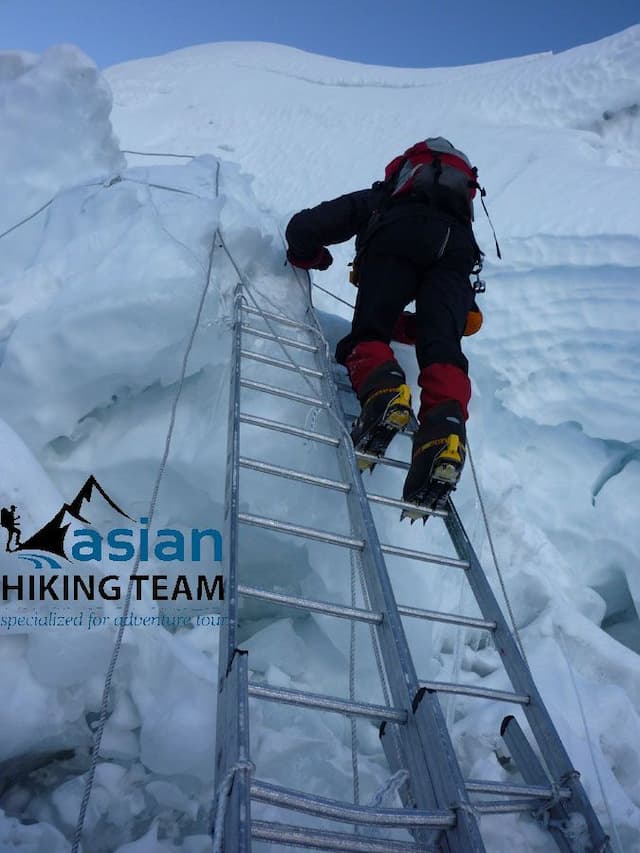
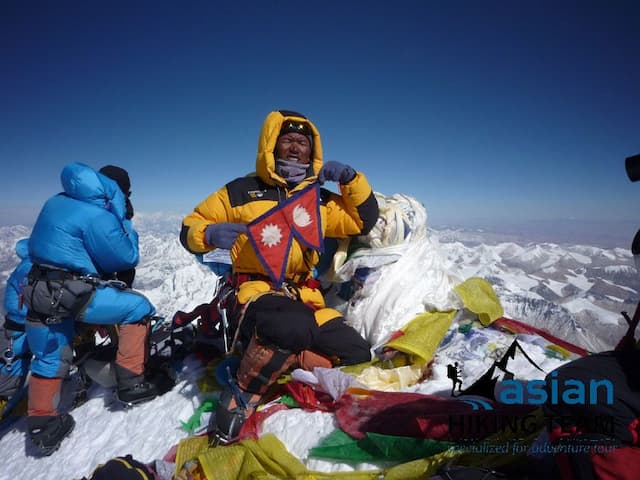
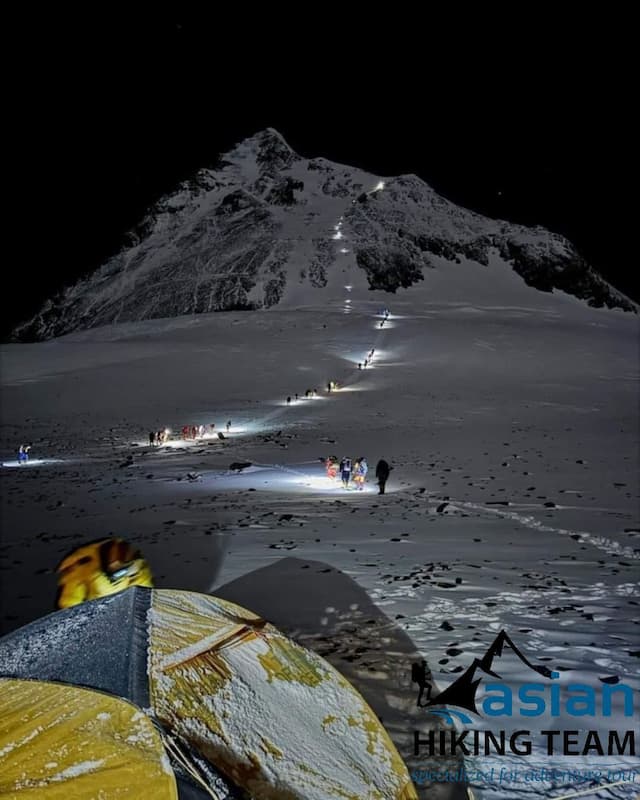
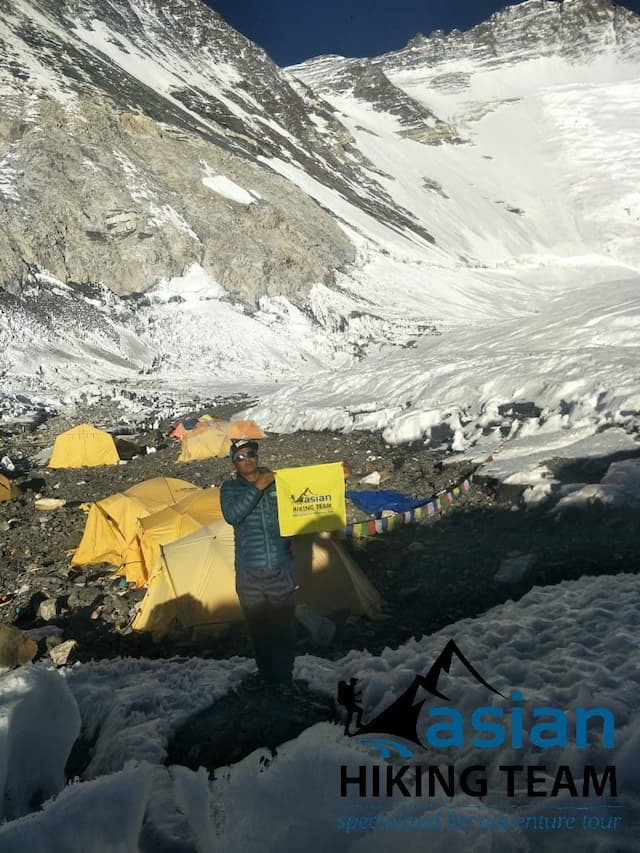
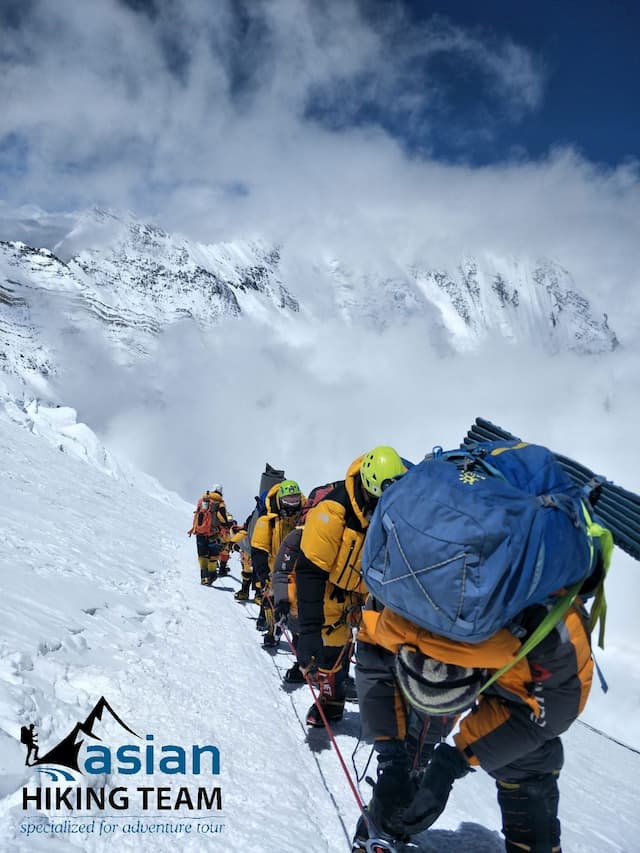






 0
0